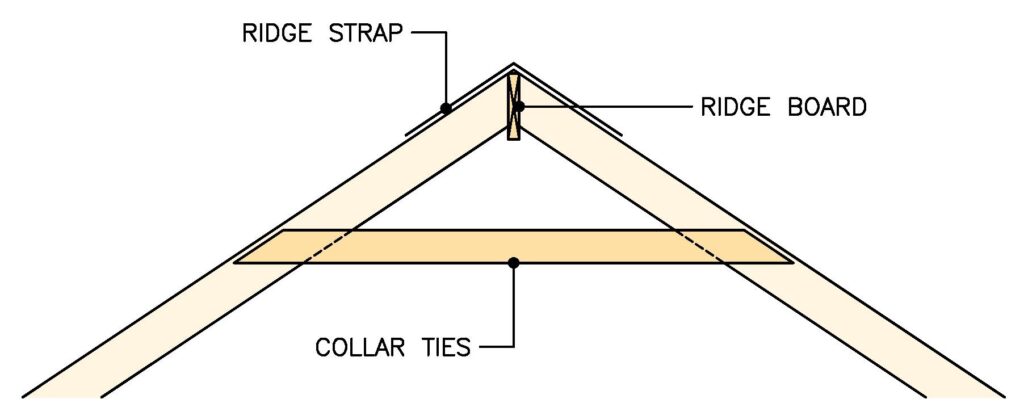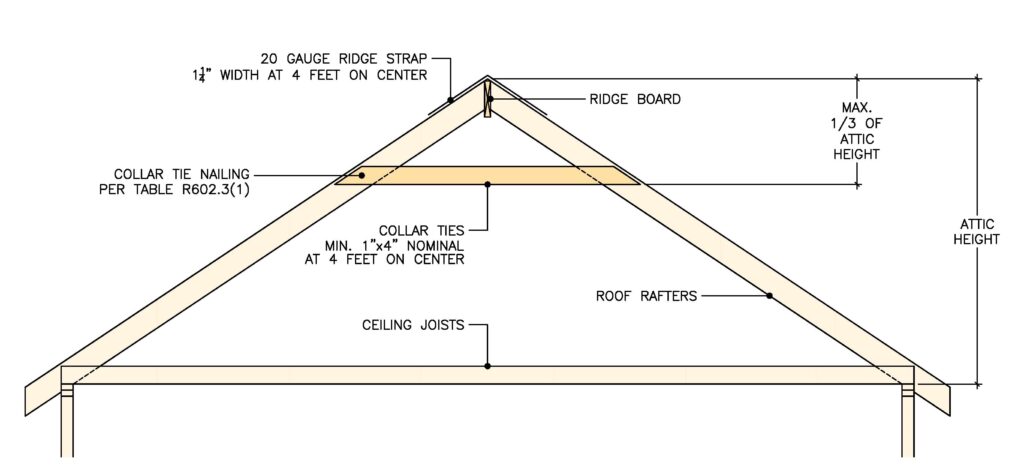Have you ever looked up into the attic and noticed small horizontal members spanning from one rafter to another and asked what those where and what they where for?
Well if the members you have seen looks like the below, then you must be referring to collar ties.

But did you know there are code requirements as to where and how these collar ties must be connected?
Section R802.4.6 of the 2018 International Residential Code specifies the requirements for collar ties. Let’s get into what these code requirements are.
What does a Collar Tie do?
Collar ties are used to connect opposing rafters in order to resist the ridge uplift cased by wind loads.
Where Should Collar Ties be Placed?
When it comes to collar tie placement, the code specifies that collar ties are to be located in the upper one-third area of the attic space up near the ridge and shall not be spaced more than 4 feet on center.
Collar Tie Material and Size
The code specifies that a collar ties must not be less than a 1 inch x 4 inch nominal wood member.

How Should Collar Ties be Connected?
The minimum connection requirements for collar ties must be per Table R602.3(1). This table in the code is the nailing schedule which calls out how to fasten wood members given a typical scenario. For collar ties, you can see a section of this table below that specifies the required fasteners.

Collar Tie Alternatives
By now you know that a collar ties is a wood member with a nominal size no less than 1 inch x 4 inch, spaced no more than 4 feet on center, and located within the upper one-third area of the attic space.
What if you did not want to install collar ties in the attic area? Is there another option?
Well the code does allow another option. In lieu of collar ties, the code allows you to use metal collar ties also know as ridge straps. These straps must also be space no more than 4 feet on center and be a minimum 20 gauge with a 1-1/4 inch width.
To see how ridge straps must be fastened, we must refer back to Table R602.3(1) above which basically is the same as collar ties.
Collar Ties vs Rafter Ties
Many people confuse collar ties with rather ties. Even though they sound like they have similarities, they are very different. While collar ties are used to resist ridge uplift caused by wind loads, rafter ties resist rafter uplift (thrust) caused by wind pressure applied against the wall which moves up under the roof overhangs.
While collar ties are located in the upper one-third area of the attic, rafter ties are located in the lower one-third area of the attic space.
Also while a collar ties needs to be no less than a nominal 1 inch x 4 inch member, a rafter tie must not be less than a 2 inch x 4 inch member.
Rafter ties are a completely separate topic of discussion but as for now this outlines some of the differences between a collar tie from a rafter tie.
So this sums up the basic code requirements for collar ties.
For more information regarding detailed requirements, be sure to check out Section R802.4.6 of the 2018 International Residential Code (IRC).
.
* Reference Source – 2018 International Residential Code – [Buy on Amazon]
Want to become a Residential Plans Examiner?
Test your knowledge with 2 full practice exams based on the Residential Plans Examiner Exam & 1 Plan Review Test.

$39.99
Includes 2 Practice Exams, 60 Questions Each, & 1 Plan Review Test, 30 Questions
This practice exam is designed for those who are looking to take the 2015 or 2018 R3 Residential Plans Examiner Certification Exam administered through the International Code Council (ICC).
These practice exams are intended to help you prepare for the actual exam by helping you navigate through the code book to familiarize yourself with the specific code sections. They will test your knowledge on the exam content areas covered to improve your chances of passing the certification exam. This is a great way to prepare yourself for the actual exam administered by ICC.
